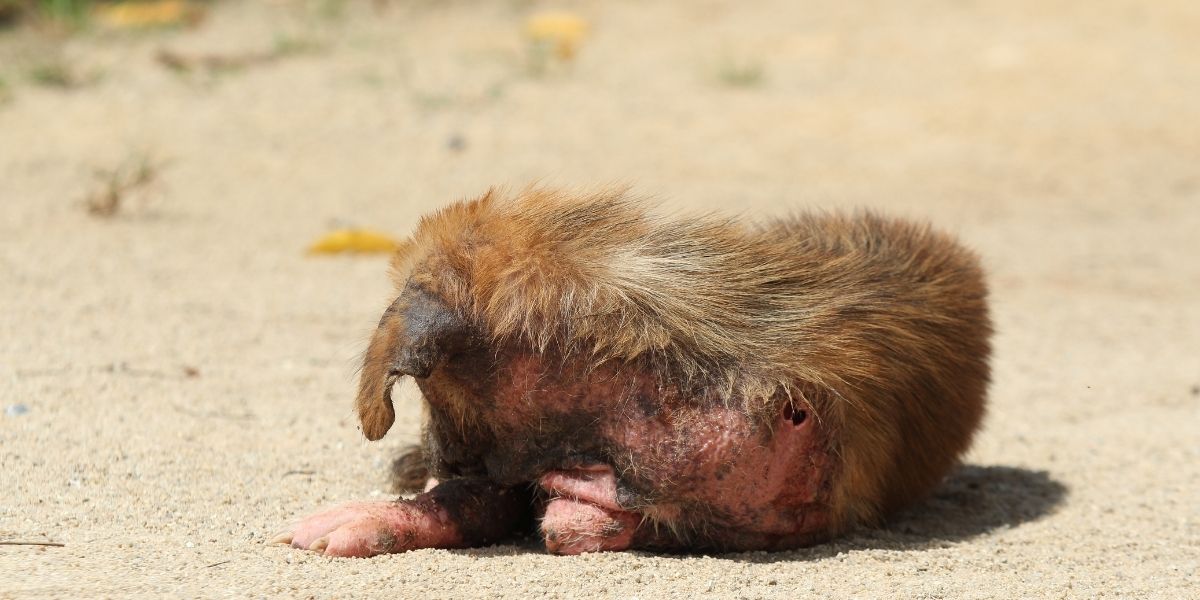Scabies in dogs – Causes. Symptoms. Treatment
Scabies in dogs is a disease that can affect all breeds of dogs, regardless of size or age. Usually, this condition occurs especially in spring and winter, in malnourished dogs, with inadequate hygiene, in pregnant or lactating females. Scabies can be transmitted from one animal to another or contract from the environment, where parasites can last for two to four weeks. The signs that your pet has scabies are visible to the naked eye. You should visit your veterinarian to correctly diagnose what type of itching the animal is suffering from and prescribe treatment for this disease.
In this article, we will show you the causes, types, symptoms of scabies in dogs, as well as what treatment your pet should follow to recover as soon as possible.
Scabies in dogs – Causes
Scabies in dogs is caused by certain mites that attack the skin and can cause deep wounds if not removed in time. There are three types of microscopic mites: Cheyletiella, Demodex, and Sarcoptes. Each type of mite causes different kinds of scabs. A dog can quickly take this disease from another dog that is sick with the scab, from cats, cows or sheep, or simply from the grass if your pet is placed in a place where previously sick animals are. This scabies at the base of scabies can last in the grass or on the ground for a week, especially during spring’s hot or rainy periods. A dog with health problems or low immunity will get sick much faster. Dogs diagnosed with scabies should be kept isolated so that there is no risk of infecting other animals.
Scabies in dogs – types of scabs
Scabies in dogs can be of three types:
– Demodecal scabies
– Cheiletielosis or Cheyletiella
– Sarcoptic scab
Demodectic Mange (scabies)
Demodectic scabies is a type of scabies in dogs and is caused by Demodex Canis. This type of scabies is a non-itchy skin condition caused by excessive multiplication of hair follicles and sebaceous glands. The parasite that underlies demodectic scabies is 0.20 mm in males and 0.30 in females. The complete stage of evolution of the parasite lasts about 90 days. That is why the development of the disease is slow and chronic. A sick dog will not transmit the disease to a healthy dog.
Demodectic mainly affects young dogs and evolves in three phases:
1. The dog’s hair thins – the dog’s hair above the eyes and at the corner of the lips thins. The skin will become oily due to the appearance of a large amount of sebum. The dog does not scratch in this first stage of the disease.
2. Hair thinning becomes more evident – in the second phase of demodectic scratching, the rare hair surfaces become more obvious, visible on the limbs. Due to inflammation of the skin, edema of the eyelids occurs.
3. The lesions spread all over the body – after three months from the contraction of demodectic scabies, the hairless portions will apply all over the body. The skin will suffer visible, bloody, or wet lesions. The animal will get a repulsive odor. Due to open wounds, the dog may get staph, which leads to abscesses. The animal will look old
The veterinarian will diagnose this type of scabies by a microscopic examination of the diseased skin tissue. A portion of the skin will be harvested with the scalpel.
Cheiletielosis or Cheyletiella
Cheiletielosis or scabies Cheyletiella is a type of scabies found in dogs. This type of condition is caused by large, white mites that settle on the skin’s surface. The itch spreads along the dog’s neck and spine. Cheiletiezol is manifested by a red rash, the skin becoming scaly.
Cheyletiellas are caused by mites belonging to the genus Cheyletiella, being very small. The eggs of these mites attach to the hair of animals with the help of filaments, secreted by the female. The life cycle takes place on the host, but it can also survive outdoors for a few weeks. Therefore, it can contaminate other dogs that spend their time in that infested environment.
Cheyletielosis is manifested by pruritus, the appearance of dandruff, mainly located on the back or neck of the animal. You need to take this type of infection of your pet very seriously, as it can also be transmitted to humans.
A veterinarian requires a correct diagnosis of the type of scab that your dog has. The doctor will perform a scotch test to confirm the presence of mites on the dog’s skin. These samples will be analyzed under a microscope.
Sarcoptic Mange (scabies)
Sarcoptic Mange (scabies) is another scabies that can be found in dogs. This type of scabies is caused by a mite called Sarcoptes. Scabies is contagious and can be transmitted immediately from one dog to another or even to humans. Therefore, pet owners should be cautious with dogs if they notice signs of scratching. Scabies is manifested by the appearance of lesions on the animal’s skin, similar to mosquito bites. Symptoms of sarcoptic Mange usually appear one week after exposure.
The dog will become restless and start scratching frantically. If the itch is not treated in time, the disease will spread to the entire surface of the animal’s body, and the treatment will not be as effective.
Scabies in dogs – Symptoms
Scabies in dogs can be easily identified by animal owners, as the signs are visible. Itching symptoms in dogs occur at an incubation period of 14-21 days. In most cases, there are:
– Itching
– Dandruff
– Hairless areas
– Intense scratches
– Skin rash
– the loss of appetite
– Weight loss
– Crusts, shells on the snout, head, around the eyes
– Injuries – the dog may self-harm due to excessive scratching
The animals most exposed to scabies are dogs that live in shelters, in shelters or unhygienic conditions. Also, dogs with a weakened immune system will be safe targets for these mites. Pregnant females have a weakened immune system and can transmit scabies to their chicks at birth. Pet owners should be careful that their dogs do not contact other dogs that show the above symptoms.
Scabies in dogs – Treatment
Scabies in dogs can be treated with several types of treatment. After a thorough examination, the veterinarian will decide which is the most effective treatment scheme for the dog with scabies. Special ointments will be administered that will be applied directly to the animal’s skin. Also, constant washes will be performed with special shampoos to remove mites. You should know that your pet will need prolonged treatment, as most treatments do not have an effect against the eggs that parasites lay, acting only against live mites.
On the Biotur Shop platform, you will be able to find the right treatments for fighting scabies in dogs. Your pet deserves all the attention to have a healthy and active lifestyle.



